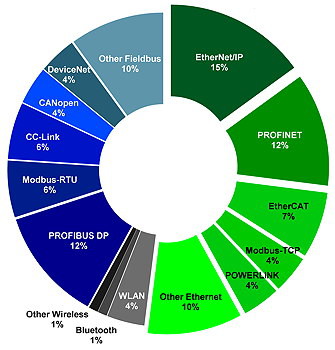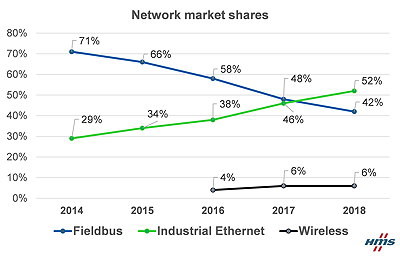- Home » News » World News
Industrial Ethernet sales overtook fieldbus in 2017

Industrial Ethernet has for the first time overtaken traditional fieldbuses in terms of the number of new nodes installed for factory automation, according to the latest in a series of annual surveys of the industrial networking market conducted by HMS Industrial Networks. During 2017, industrial Ethernet accounted for 52% of new installed nodes (up from 46% in 2016), while fieldbus nodes dropped from 48% to 42% of the market. EtherNet/IP is now the most widely installed network, with 15% of the market, followed by Profinet and Profibus, both on 12%. Wireless technologies held steady with a 6% market share.
HMS’ analysis, based on its own sales figures and other sources, shows that the number of industrial Ethernet nodes installed last year grew by 22% compared to 2016. EtherNet/IP has emerged as the largest industrial Ethernet network, followed by Profinet, EtherCat, Modbus-TCP and Ethernet Powerlink.
“We have seen the transition to industrial Ethernet for a long time, but it isn’t until now that it has actually overtaken fieldbuses when it comes to number of new installed nodes,” says HMS’ chief marketing officer, Anders Hansson. “The transition is driven by the need for high performance, integration between factory installations and IT/IoT-systems, as well as the Industrial Internet of Things in general.”
Despite being overtaken by Ethernet, sales of fieldbus nodes are still expanding with a growth rate of 6% in 2017, up from 4% in 2016. These sales have been boosted by a strong market and by cyber-security concerns, according to HMS. However, the networking supplier expects the number of fieldbus installations to decline steadily over the next few years. The dominant fieldbus is still Profibus, with 12% of the global market, followed by Modbus-RTU and CC-Link, both on 6%.
Although the number of wireless nodes installed grew by 32% in both 2016 and 2017, the technology’s relatively small share of an expanding market held steady at 6% for both years. WLANs are the most popular wireless technology, followed by Bluetooth.
“Wireless is increasingly being used by machine-builders and system integrators to realise innovative automation architectures,” says Hansson. “Users can reduce cabling and create new solutions for connectivity and control, including Bring Your Own Device (BYOD) solutions via tablets or smartphones.”

Breaking down the global market into regions, HMS finds that in Europe and the Middle East, Profinet and EtherNet/IP are the leading networking protocols and that Profibus is still used widely. Other popular networks include EtherCat, Modbus TCP and Ethernet Powerlink.
The US market is dominated by the CIP networks, with a clear movement towards EtherNet/IP. In Asia, no single network stands out as the market-leader, but Profinet, EtherNet/IP, Profibus, EtherCat, Modbus and CC-Link are all used widely, with the Ethernet version CC-Link IE Field also gaining traction.
“Our study confirms that the network market remains fragmented – users continue to ask for connectivity to a wide variety of networks, depending on application,” Hansson concludes. “Looking ahead, it is clear that industrial devices will become increasingly connected, boosted by the Industrial Internet of Things and Industry 4.0. From our point of view, we are well-suited to grow with these trends, since HMS is all about ‘connecting devices.’”






